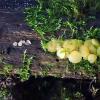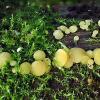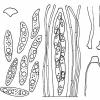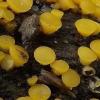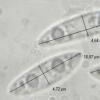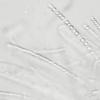
16-01-2026 00:45
Ethan CrensonHi all, On decorticated hardwood from a New York

10-01-2026 20:00
Tom SchrierHi all,We found picnidia on Protoparmeliopsis mur

13-01-2026 07:28
 Danny Newman
Danny Newman
Chlorociboria glauca on indet. decorticate logThe

08-12-2025 17:37
 Lothar Krieglsteiner
Lothar Krieglsteiner
20.6.25, on branch of Abies infected and thickened

15-01-2026 15:55
 Lothar Krieglsteiner
Lothar Krieglsteiner
this one is especially interesting for me because

13-01-2026 08:43
 Danny Newman
Danny Newman
Tricladium varicosporioides on indet. decorticate

07-01-2026 22:22
 Danny Newman
Danny Newman
Tatraea sp. on indet. hardwood The Swag, Great Sm

13-01-2026 09:10
 Danny Newman
Danny Newman
Dasyscyphella chrysotexta on indet. decorticate ha

13-01-2026 10:13
 Danny Newman
Danny Newman
Cordieritidaceae sp. on indet. wood w/ Hypoxylon s
Asques longuement claviformes, 130-185 x 8-12 µm, crochets +, IKI très faiblement + mais pas certain (artefact ?).
Spores elliptiques avec de nombreuses gouttes jamais rangées de manière régulière et accompagnées de nombreuses guttules. Certaines spores sont plus étroites vers le centre. Quelques unes présentent une cloison. Hétérosporie importante : 14-21 x 5-6 µm.
Pas trouvé d'espèce correspondant surtout à cause de ces paraphyses très étrites et sans goutte.
Gilbert

my first idea is Ph. monticola. Does anything not fit? The empty-looking paraphyses exclude Ph. epiphyllum (miltiguttulate), although Ph. monticola has elongate Vbs.
Zotto
Gilbert
If the subject is P. monticola, could you explain how this species differs from P. epiphylus?
Can the shape of the fruiting bodies also be an important feature during identification?
Sorry to ask but I still have trouble distinguishing them.
.
Thanks in advance.
Mirek

the colour is more yellow in monticola, more whitish-cream but also cream-yellow in epiphyllus.
The best character in my opinion is the content of the living paraphyses: multiguttulate VBs in epiphyllus, elongate VBs in P. monticola.
Genetically the two are very distant, therefore even the same genus is doubted.
Zotto
The first are large to several millimeters in diameter and grow on a variety of hardwoods. They are very common with me.
The other ones are very small, up to 1 mm in diameter, and I found them on leaves. The ones I present grew on Betula leaves.
Identical microscopic features?
Mirek

But the yellow colour of the first appears to be also possible in that species, and the VBs tell for that.
For instance, Hymenoscyphus epiphyllus, Eckel-1/2 looks like yours (I had it wrongly in monticola).
Your two samples do not look like very different in apo size, though.
The others are on a 1: 1 scale
Fruitbodies marked with number 1 grow up to 6 mm.
I marked the number 2 with a maximum size of 1 mm.
Initially I marked them as Hymenoscyphus epiphyllus but without certainty.
thank you very much!
Mirek

